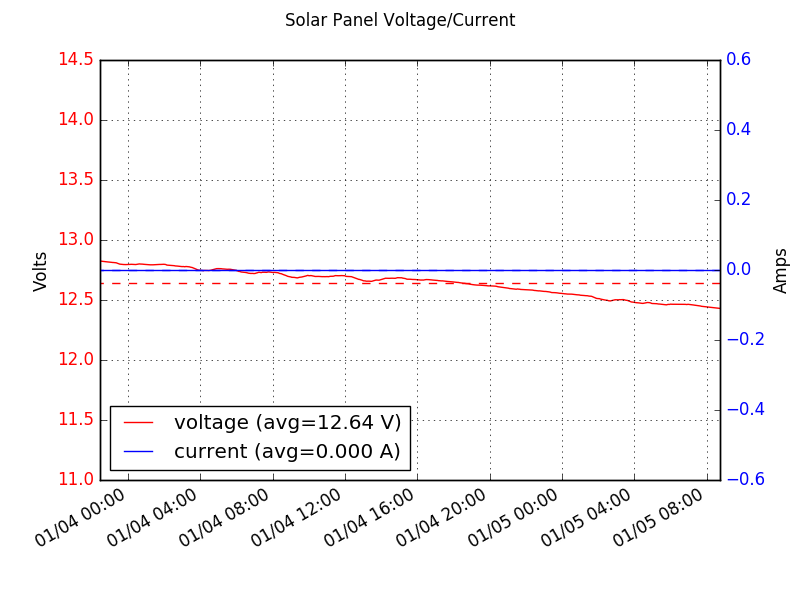Previously I had written up a bit on my project that I have called my “solar satellite station.” I used quotes around the word “solar” in the title because for the past couple of months, it has mostly been sitting on my workbench in my garage, occasionally powered up by a 12V charger rather than the sun. My hope is to get it out into the sunshine fairly soon, but that’s rather waiting on a couple of changes to the software. Most importantly, it consumes rather too much power than I would like which I suspect is that it runs continuously, even though it samples the data (temperature, pressure and current) only periodically. If I utilized the deep sleep mode of the ESP8266, chances are excellent it would reduce the power consumption by a factor of ten or more.
But that is a post for another day. Today, I thought I would bore you with graphs from the data that I’ve been logging. Currently I have detached my charger, so it has been running from the battery power (a 7.2Ah lead acid battery, if you haven’t been following along). First, the temperature in my garage:

The skies were clear last night, but we are expecting some rain today (indeed, it’s already begun) and we don’t have much sun today, so I would expect it to be a bit chilly. On to atmospheric pressure:

This was sensed with the MPL3115A2 sensor from adafruit. This is about as significant a drop as I’ve seen in recent memory. The prediction is that we are going to see three or more inches of rain in the next couple of days. Neat.
Now, onto power and current consumption. I have separate INA219 voltage/current sensors monitoring the lines to the solar panel as well as the battery. The “solar panel” in this case is currently an unplugged charger. As you can see the current is zero amps, so the battery is not being charged at all. The voltage has dropped by about half a volt in the thirty six hours or so that the graph spans. The voltage is actually pretty much equal to the battery voltage, since the charge controller has a common positive between the panel and battery circuits. Power is the product of voltage and current, and is of course zero as you would expect.

Moving on to the battery side of things:

The battery side indicates the total consumption of all elements of the system. You can see that it’s average about 74 milliamps at 12.65 volts, or about 936 milliwatts. This is the combined consumption from the charge controller and its inefficiencies, as well as powering the two ESP8266 (one is still being used as a serial bridge for debugging) and all the various I2C sensors. If we call that 1W, then we can estimate the total capacity of the setup pretty easily. The battery is a nominal 12V at 7.2Ah, or 86.4 Watt/hours. That means that we’d discharge the (large and rather heavy battery) in under four days. Since I really want the battery to be discharged no deeper than 50%, a couple of days is probably all it can really take.
I know I can do better. Currently it’s maintaining two processors, each with their own WiFi connections. If I removed my debugging one, power would immediately drop by half. And I really need to get back to using deep sleep mode. I prototyped a deep sleep version of the code that just sent temperature, but I haven’t worked on deploying it yet. I also want to shift to using my own MQTT server. Perhaps we’ll get to it this weekend. Until then, I’m off into my garage to cut up boxes for the recycling bin. Have a good weekend, all.